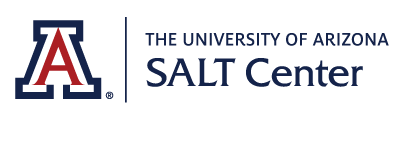1.) Navigate to our Application page
2.) Select the student type that best describes you:
- Incoming Students
- This means you have never completed any classes at the University of Arizona. You will be considered a first-year (i.e. “freshman”) student or a new transfer student.
- You will log into your Future Wildcat Account using your email address and password.
- Current University of Arizona Students
- This means you have previously taken classes at the University of Arizona or are currently taking one.
- You will log in with your NetID and Password.
3.) Select “START A NEW SALT APPLICATION” or open a saved application if you already started one previously.
Common App users: See special instructions in our FAQ section.
- Submit your application to the SALT Center as soon as possible to avoid a waiting list
- Set aside at least 30 minutes to complete the application
- You can save your application at any step to come back to later
- Once your application is complete, the SALT Center Admissions Team will review it to determine your eligibility to enroll
- Please check your university email account regularly so that you don't miss important messages about your SALT Center application and enrollment status. Email is the official means of communication for the university.
After you are notified of being eligible to enroll in the SALT Center, the completion of mandatory steps is required to finalize enrollment, including:
- Complete a SALT Center New Student Participation Agreement
- Register for a mandatory SALT Center Enrollment Event
- Pay the SALT Center Enrollment Fee
Historically, April 1st has been the date that the SALT Center has reached capacity and initiated a waiting list. SALT Center candidates are encouraged to submit a complete application and complete our enrollment steps by this date in order to have the highest chance of avoiding the waiting list.
We encourage you to commit now, and then notify us later if your plans change.
Please email any questions about the SALT Center application to uasaltcenter@arizona.edu.
Please include the candidate's first and last name in the email subject line. Allow up to 48 hours for a response. If the email comes from someone other than the candidate, they will always be included in a response when necessary and warranted.
Why we ask for documentation
- Documentation is the comprehensive testing that led to a diagnosis of a learning challenge. Providing documentation of your learning challenge is a key step to submitting your application in order to be considered eligible to enroll.
Your documentation should be the most current & comprehensive available
- Documentation from prior to high school is not useful for our review process. Students must qualify for our services and we need to ensure that our services match the student’s current academic support needs. The most current/comprehensive documentation best allows us to make this determination. Please note, you do NOT have to get new testing for our program.
Your documentation should state the following:
- Your diagnosis/es
- Challenges to learning the diagnosis presents
- Current support services
Do not password protect your documents
- This will cause a significant delay during the application review process.
What file formats are accepted?
- Documentation must be uploaded to the application electronically as a Word or PDF file.
Is there a file size limit?
- Yes. The maximum file size you can upload is approximately 20 MB (megabytes).
I do not have documentation of a learning difference, what must I do to satisfy this requirement?
- If you do not have documentation, or have never been formally diagnosed with a learning challenge, you will be prompted to answer a simple essay question:
- "Describe your history of academic challenges and the support services you have used to manage these challenges."
Does the SALT Center offer diagnostic evaluations?
- The SALT Center has partnered with the ABLE Clinic to offer comprehensive evaluations and testing to assist in diagnosis, treatment recommendations, and coordination of care. Services are available to students and other members of the Southern Arizona community. Learn More
SOME EXAMPLES OF DOCUMENTATION INCLUDE:
| Psychoeducational Evaluation | This is the comprehensive battery of testing that led to a diagnosis of a learning challenge. Psychoeducational testing refers to the psychological tests used to analyze the mental processes underlying your child's educational performance. As part of the assessment, your child will undergo psychoeducational testing. | Preferred |
| IEP | An Individualized Education Program (IEP) is a written statement of the educational program designed to meet a child’s individual needs.
The IEP has two general purposes:
| This is okay, however, we may need to contact you for additional information |
| 504 Plan | The 504 Plan is a plan developed to ensure that a child who has a disability identified under the law and is attending an elementary or secondary educational institution receives accommodations that will ensure their academic success and access to the learning environment. | This is okay, however, we may need to contact you for additional information |
| Disability Statement | This is a general statement from a physician, licensed clinical psychologist, or psychiatrist that a diagnosis of a learning difference is present. | This is okay, however, we may need to contact you for additional information |
If you have any questions about uploading your documentation, please contact us at uasaltcenter@arizona.edu.
- Include the SALT Center program fee as part of the Cost of Attending (COA) the University of Arizona
- Complete and submit the SALT Center Scholarship Award application by March 1 to be considered for a need-based award
- File a FAFSA (Free Application for Federal Student Aid) by March 1 with the U of A Office of Scholarships and Financial Aid
- Visit the Scholarship Universe website
- Visit the Office of Scholarships and Financial Aid website


